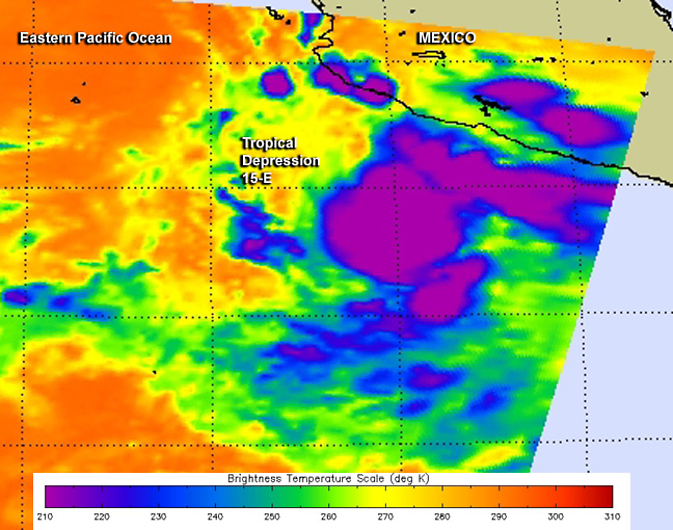NASA Catches Birth of Tropical Storm Odile

This false-colored infrared image from NASA's Aqua satellite captured the birth of Tropical Depression 15-E on September 10 at 8:53 UTC. Image Credit: NASA JPL, Ed Olsen
The Atmospheric Infrared Sounder or AIRS instrument that flies aboard NASA's Aqua satellite captured infrared data on Tropical Depression 15-E on September 10 at 8:53 UTC (4:53 a.m. EDT) when it developed.
The National Hurricane Center named the depression at 5 a.m. EDT, when the center was located near latitude 14.4 north and longitude 102.5 west.
AIRS infrared imagery reads temperature and identified the coldest temperatures in powerful thunderstorms circling the center of the newborn depression. Cloud top temperatures were near 220 kelvin (-63.6F/-53.1C).
By 11 a.m. EDT, the depression strengthened into Tropical Storm Odile. Maximum sustained winds were near 40 mph (65 kph) and Odile was drifting toward the north-northwest near 3 mph (6 kph) and is expected to drift to the north-northwest over the next two days.
Odile was located near 14.9 north latitude and 102.9 west longitude, about 220 miles (350 km) south-southwest of Lazaro Cardenas, Mexico.
The National Hurricane Center noted that on the forecast track, Odile's center will remain offshore of the southwestern coast of Mexico through Thursday night, September 11.
However, Odile is expected to create swells, rip currents and rough surf along the southwestern coast of Mexico over the next day or two.
Rob Gutro NASA's Goddard Space Flight Center
Media Contact
All latest news from the category: Earth Sciences
Earth Sciences (also referred to as Geosciences), which deals with basic issues surrounding our planet, plays a vital role in the area of energy and raw materials supply.
Earth Sciences comprises subjects such as geology, geography, geological informatics, paleontology, mineralogy, petrography, crystallography, geophysics, geodesy, glaciology, cartography, photogrammetry, meteorology and seismology, early-warning systems, earthquake research and polar research.
Newest articles

Superradiant atoms could push the boundaries of how precisely time can be measured
Superradiant atoms can help us measure time more precisely than ever. In a new study, researchers from the University of Copenhagen present a new method for measuring the time interval,…

Ion thermoelectric conversion devices for near room temperature
The electrode sheet of the thermoelectric device consists of ionic hydrogel, which is sandwiched between the electrodes to form, and the Prussian blue on the electrode undergoes a redox reaction…

Zap Energy achieves 37-million-degree temperatures in a compact device
New publication reports record electron temperatures for a small-scale, sheared-flow-stabilized Z-pinch fusion device. In the nine decades since humans first produced fusion reactions, only a few fusion technologies have demonstrated…





















